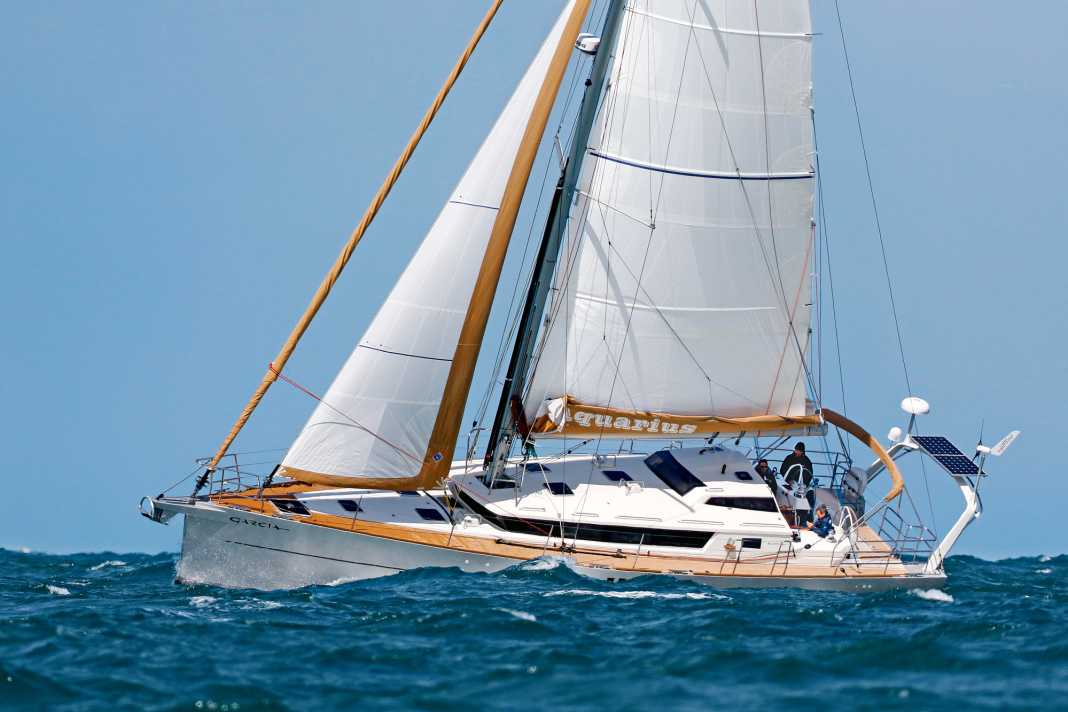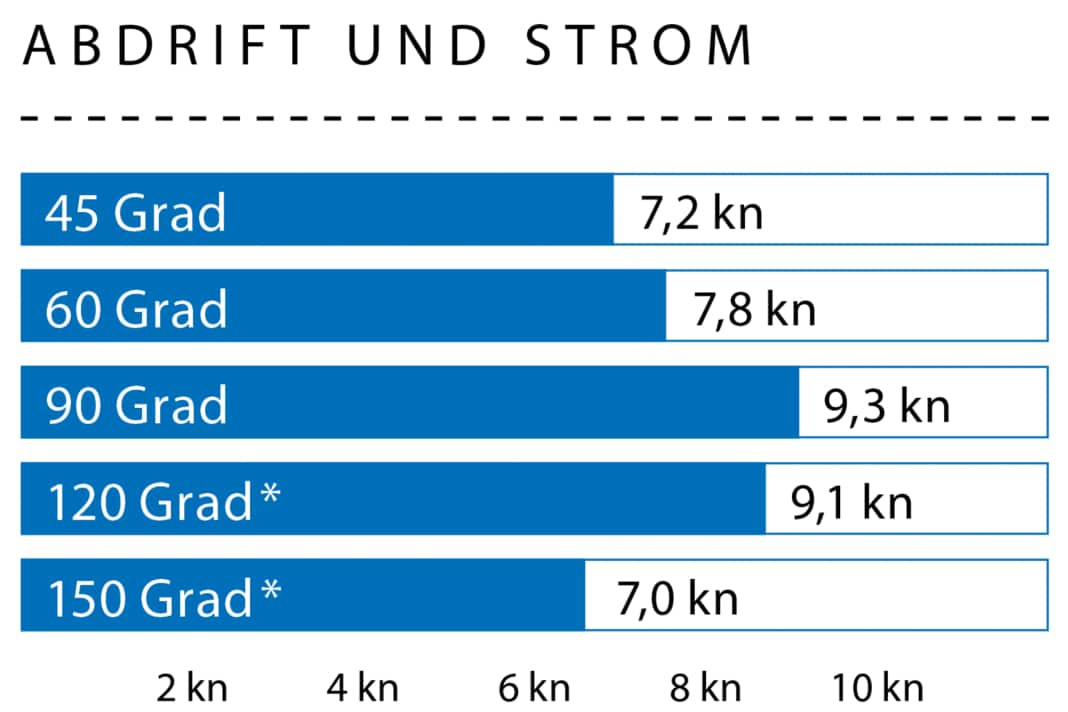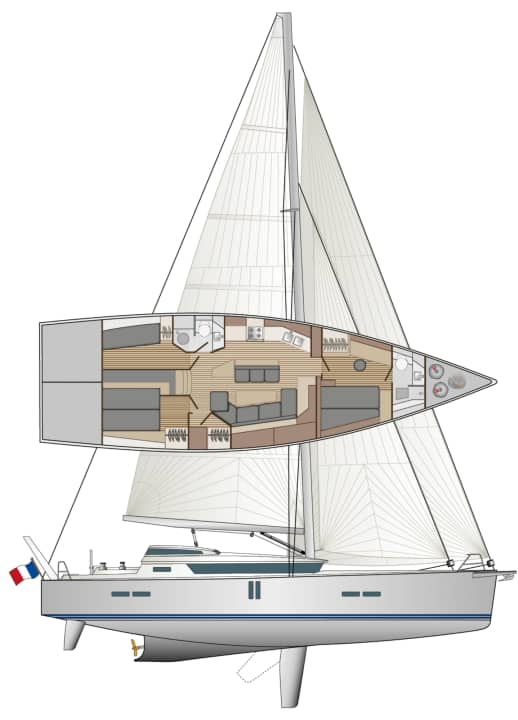Garcia Exploration 52: Robust explorer yacht with an uncompromising focus put to the test
Michael Good
· 22.10.2024






- Ships from Garcia in the extreme north or south
- No problem with wind and waves
- For driving and experiencing
- All-round view thanks to deck saloon
- A lot of ship, a lot of money
- The measured values for the test of the Garcia Exploration 52
- The Garcia Exploration 52 in detail
- Price and shipyard
- YACHT review of the Garcia Exploration 52
The very first time you see it in the harbour, you feel a sense of awe. There are around 20 tonnes of indestructible aluminium in the shape of a ship - solid, grey, coarse and by all accounts extremely robust. An armoured cruiser indeed, next to which the neighbouring GRP yachts on the jetty look dainty or almost fragile in comparison.
Describing the concept is simple: the Exploration 52 from Garcia Yachting in France is designed to undertake demanding sailing trips in the high latitudes. Nothing less; no compromises are envisaged. Sportiness, for example, or special elegance are not on the agenda. There is only one destination for the yachts in the Exploration line, and that is as far away as possible.
Also interesting:
In spring 2014, Garcia Yachting unveiled the Exploration 45, a ship for worldwide, unrestricted long-distance cruising. Jimmy Cornell, a recognised ocean expert and founder of the ARC (Atlantic Rally for Cruisers), contributed significantly to the project with his experience. Together with the architects at Berret/Racoupeau and the designers at Garcia Yachting, Cornell designed a ship with which he wanted to sail through the Northwest Passage. He finally succeeded in this endeavour on his second attempt. The Exploration 52 is the larger follow-up model with exactly the same unique DNA.
Ships from Garcia in the extreme north or south
Garcia Yachting and Allures Yachting (both aluminium specialists) produce their boats together in the same shipyard in Tourlaville near Cherbourg. Both brands operate under the umbrella of the Grand Large Yachting group, which also includes the catamaran builders from Outremer and the US brand Gunboat with its powerful performance cats.
As Sales Manager at Grand Large, Olivier Vantrepol is responsible for both Garcia and Allures. He explains the difference between the brands: "Both boats are suitable for sailing around the world. The Garcia boats prefer to sail along the meridians to the north and south. Allures, on the other hand, builds boats that are more suited to sailing along the meridians."
What this means in concrete terms can be seen in production. While Allures Yachting's boats are already considered to be very robustly built and particularly seaworthy, Garcia's yachts raise the bar in terms of safety and durability to the next level.
For the hull of the Exploration 52, aluminium plates of six (above the waterline) and eight millimetres (below) are pressed into shape and welded stress-free over a frame structure. Allures uses the same construction method, but the plates are less thick and the ships are lighter overall.
Garcia Yachting even uses plates ten millimetres thick for the floor element. This means that the Exploration 52 could break through ice if it is not too thick. And the boat can also easily fall dry on almost any surface. The Exploration remains on its flattened hull at the bottom and on its long ballast keel as an extension. The two rudder blades are not loaded during this action.
Like Allures, Garcia also builds its yachts exclusively as integral centreboards. The option of a fixed keel is not currently planned. In the case of the Exploration 52, the swivelling fin can reduce the draught from three metres to a minimum of 1.27 metres. This would also make it possible to navigate shallow waters, but only with an engine. This is because the Exploration only sails to a limited extent with the centreboard raised, especially in windy conditions.
No problem with wind and waves
Fortunately, there is enough water for the test off the harbour of Cherbourg, and there is also enough wind. The average speed is 15 knots with gusts of up to 18 knots, plus a swell of around 1.5 metres - conditions in which the fun really begins on a ship like the Exploration 52. With the powerful genoa and a reef in the mainsail, the large, 20-tonne aluminium yacht quickly reaches a good speed of just over 7 knots on a course of 45 degrees to the true wind.
For a ship of this orientation, however, the mere performance data is only of limited significance. More importantly, the Exploration displaces the incoming waves without any problems and starts very cleanly and smoothly even on a course close to the wind. Steering the boat on the windward edge is easy and smooth, even if the double rudder blades mean that there is hardly any feedback on the steering. This makes it all the easier for the autopilot, which probably steers most of the time on the long strokes anyway. And it also requires less power.
As a test, the genoa is replaced by the self-tacking jib furled on the cutter stay, but the mainsail is reefed out again. The Exploration is able to run around five degrees higher with this jib, but loses around half a knot of speed in the process. The self-tacking jib is an extra on special customer request; it is actually too small and too narrow for the ship. Normally - but also only as an option - the ship would be equipped with a conventional cutter staysail in addition to the large genoa and for more wind.
Manoeuvring on board is incredibly easy. Four large and well-placed winches ensure orderly manoeuvres, and all sheets, reefing and trim lines are led back into the cockpit in channels below deck. If the customer chooses the cutter stay option as usual, the large genoa must be pulled through at the front during manoeuvres. In this case, the distances for hauling tight are long and electric winches are indispensable as an option.
For driving and experiencing
Anyone planning a long sea voyage and choosing a ship from Garcia's Exploration line should take enough time to familiarise themselves with all the details of the on-board technology on and below deck. The ship has a very complicated structure and the owner must know how and where to access the technical installations for maintenance, inspection and repair. That is a task.
However, the shipyard has gone to great lengths to ensure that the technical systems and all their functions are easily accessible. This applies to the built-in engine, the controls, the electrics and the water supply network.
Ventilation and heating are important issues on board an Explorer yacht, especially when travelling to the Arctic Ocean. The Exploration 52 is therefore equipped with an active ventilation system right from the shipyard, as well as a hot water heating system and radiators in all living areas. In addition, the hull above the waterline, the deck and the superstructure will be insulated with eight centimetres of foam insulation. This also meets the shipyard standard.
However, despite the supposedly perfect sound and heat insulation, the 110 hp built-in diesel engine from Volvo Penta produces quite a lot of noise below deck. When cruising, the noise level in the aft cabin is at the limit of tolerability at 80 decibels. It is also quite loud in the saloon at 76 decibels.
All-round view thanks to deck saloon
Like its smaller sister, the Exploration 45, the 52 is a true deck saloon yacht. This means a raised seating area with an all-round view through the large superstructure windows, plus a long galley to the side with large work surfaces and plenty of usable storage space. On larger boats, the shipyard can convert the space under the raised dinette into an additional cabin with a single bed or set up a walk-in workshop. Variants with two single berths or double beds are also possible for the aft cabins. In general, the customer can have a large say in the layout of the interior fittings.
In the owner's cabin at the front, the shipyard has moved the wet room completely forward and added the double berth to the side. This arrangement should allow the occupants to move around the cabin more freely and make better use of the space. There is also a small work surface at the front.
Garcia Yachting obtains the interior fittings with all the furniture from an external supplier and fits the parts into the finished aluminium hull. The workmanship and quality are good. However, the teak veneers of the individual built-in elements on the test boat were not nicely matched, which is distracting to the eye.
A lot of ship, a lot of money
Slightly more than 830000 euros is what the Exploration 52 from Garcia Yachting costs ex shipyard, including the sails and the basic seaworthy equipment. The price is difficult to categorise because there are hardly any comparable boats on the market. The money is paid by adventurers who are looking for the extreme, or customers who want to play it safe in every situation. For both, this boat can be whatever you want it to be.
The measured values for the test of the Garcia Exploration 52




The Garcia Exploration 52 in detail

Technical data of the Garcia Exploration 52
- Design engineer: Berret/Racoupeau
- CE design category: A
- Torso length: 15,84 m
- Width: 4,80 m
- Draught (integral draught): 1,27-3,00 m
- Weight: 19,5 t
- Ballast/proportion: 6,6 t/34 %
- Mainsail: 61,0 m2
- Furling genoa (106 %): 58,0 m2
- machine (Volvo P.): 81 kW/110 hp
Hull and deck construction
Hull and deck made of marine aluminium welded in a round frame. Superstructure roof as GRP sandwich construction
Price and shipyard
- Base price ex shipyard: 1,351,570 euros incl. 19 % VAT.
- Guarantee: 2 years
Shipyard
Garcia Yachting, FR-50100, Tourlaville; www.garcia-yachting.com
Distribution
YACHT review of the Garcia Exploration 52
Extremely robustly built explorer yacht made of aluminium in an uncompromising design for demanding and long tours in the high latitudes. With long keel, integral centreboard and double rudder blades suitable for dry-docking
Design and concept
- + Uncompromising concept
- + Extremely robust construction
- - Under-rigged with little wind
Sailing performance and trim
- + Clean insertion into the shaft
- + Clear manoeuvre sequences
Living and finishing quality
- + Flexibility in interior fittings
- + Deck saloon with a view
- + Large number of storage spaces
Equipment and technology
- + Easily accessible on-board installations
- + Hull and deck insulated
- - Under machine loud
The test first appeared in YACHT issue 13/2016 and has been revised for this online version.

